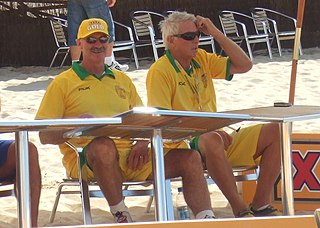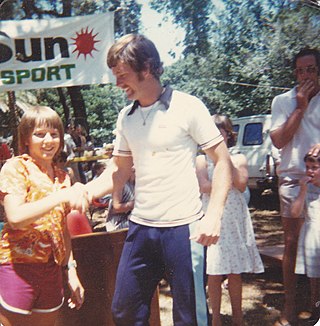Trevor Martin Chappell is a former Australian cricketer, a member of the South Australian Chappell family which excelled at cricket. He played 3 tests and 20 One Day Internationals for Australia. He won the Sheffield Shield with New South Wales twice, and scored a century for Australia against India in the 1983 World Cup. His career was overshadowed, however, by an incident in 1981 in which he bowled an underarm delivery to New Zealand cricketer Brian McKechnie to prevent the batsman from hitting a six.
Graham Neil Yallop is a former Australian international cricketer. Yallop played Test and One Day International cricket for the Australia national cricket team between 1976 and 1984, captaining the side briefly during the World Series Cricket era in the late 1970s. A technically correct left-handed batsman, Yallop played domestically for Victoria, invariably batting near the top of the order and led Victoria to two Sheffield Shield titles. He was the first player to wear a full helmet in a Test match.
Raymond James Bright is a former Australian Test and One Day International cricketer from Victoria. He was a left arm spin bowler and lower order batsman who captained Victoria for a number of seasons. He was also an Australian vice-captain.

Jeffrey Robert Thomson is a former Australian cricketer. Known as "Thommo", he is one of the fastest bowlers in the history of cricket; he bowled a delivery with a speed of 160.6 km/h against the West Indies in Perth in 1975, which was the fastest recorded delivery at the time, and the fourth-fastest recorded delivery of all time. He was a part of the Australian squad which finished as runners-up at the 1975 Cricket World Cup.
John Dyson is a former international cricketer (batsman) who is now a cricket coach, most recently in charge of the West Indies.
Wayne Bentley Phillips is a former Australian cricketer who played in 27 Test matches and 48 One Day Internationals (ODIs) between 1982 and 1986 as a batsman and wicket-keeper. He played for South Australia between 1978 and 1991.
Rodney Malcolm Hogg is an Australian former cricketer. He was a fast bowler. Hogg played in 38 Test matches and 71 One Day Internationals between 1978 and 1985. In Tests he took 123 wickets at an average of 28.47. He is best remembered for taking 41 wickets in his first six tests during the 1978–79 Ashes.
Leonard Stephen Pascoe is a former Australian Test and One Day International cricketer.
Richard Bede McCosker is a former Australian cricketer. He was a part of the Australian squad which finished as runners-up at the 1975 Cricket World Cup.

Stephen John Rixon is an Australian cricket coach and former international cricketer. He played in 13 Test matches and six One Day Internationals between 1977 and 1985. He has coached the New Zealand cricket team, New South Wales cricket team, Surrey County Cricket Club, Hyderabad Heroes and the Chennai Super Kings of the Indian Cricket League and was the fielding coach of the Australian national cricket team, Pakistan national cricket team and Sri Lanka national cricket team.
Bruce Malcolm Laird is a former Western Australian and Australian cricketer. He was an opening batsmen who played in 21 Test matches and 23 One Day Internationals. He also played 13 "Supertests" in World Series Cricket. He was a part of the Australian squad which finished as runners-up at the 1975 Cricket World Cup.
Geoffrey Dymock is an Australian former international cricketer. He played in 21 Test matches and 15 One Day Internationals between 1974 and 1980. On his debut, he took five wickets in the second innings against New Zealand in Adelaide in 1974. He was the third bowler to dismiss all eleven opposition players in a Test match, and remains one of only six bowlers to have achieved this.
Gary John Gilmour was an Australian cricketer who played in 15 test matches and 5 One Day Internationals (ODIs) between 1973 and 1977. He was a part of the Australian squad which finished as runners-up at the 1975 Cricket World Cup.
Ian Charles Davis is an Australian former cricketer (batsman) who played in 15 Test matches and three One Day Internationals between 1973 and 1977. Davis retired from first-class cricket in 1984 then worked for Dunlop Slazenger until his retirement in 2010.
Alan George Hurst is a former Australian cricketer who played in twelve Test matches and eight One Day Internationals between 1975 and 1979. He was a part of the Australian squad which finished as runners-up at the 1975 Cricket World Cup.
Gary John Cosier is a former Australian international cricketer who played in 18 Test matches and nine One Day Internationals between 1975 and 1979. Cosier's star shone very briefly following a sensational debut, when he became only the ninth Australian to post a century in his first Test.
James Donald Higgs is a former Australian leg spinner who played in 22 Test matches between 1978 and 1981. In the words of Gideon Haigh "Jim Higgs was Australia's best legspinner between Richie Benaud and Warne. His misfortune was to play at a time when wrist-spin was nearly extinct, thought to be the preserve only of the eccentric and the profligate, and so to find selectors and captains with little empathy with his guiles."
Robert Samuel Langer was an Australian cricketer who played for Western Australia in the 1970s and 1980s. He was a left-handed middle order batsman and occasional right-arm medium pace bowler. Langer's first-class career extended from 1973–1974 until 1981–1982. He made 2,756 first-class runs in 44 matches at an average of 43.06 with a highest score of 150 not out. In 15 limited overs matches, his best score was 99 not out in a total of 338 runs at 28.16 average. Langer scored five first-class hundreds and 18 half-centuries during his career.
The 1975 Cricket World Cup Final was a One Day International cricket match played at Lord's, London on 21 June 1975 to determine the winner of the 1975 Cricket World Cup. It was the second time that the West Indies and Australia had met in the tournament after playing against each other in the group stage. The West Indies won the match by 17 runs to claim their first title.
The 1980–81 Sheffield Shield season was the 79th season of the Sheffield Shield, the domestic first-class cricket competition in Australia. It started on 17 October 1980 and finished on 9 March 1981. Going into the final round of matches, New South Wales, Western Australia and Queensland were all in a position to win the Shield. It would be Western Australia, who found form in the second half of the season with four straight victories, who would emerge victorious, drawing against Queensland to secure its eighth championship.

